 “Our elected officials at every level of government must hear from their constituents that this is a priority. Audubon is committed to protecting the places birds need now and in the future and taking action to address the root causes of climate change.” – Renee Stone, Vice President of Climate for the National Audubon Society
“Our elected officials at every level of government must hear from their constituents that this is a priority. Audubon is committed to protecting the places birds need now and in the future and taking action to address the root causes of climate change.” – Renee Stone, Vice President of Climate for the National Audubon Society
A Introductory Commentary to this News from the National Audubon Society of the United States from Niagara At Large reporter and publisher Doug Draper
Posted October 11th, 2019 on Niagara At Large
Of all of the disturbing news that has come out in recent years about the rapid acceleration of damage and destruction climate change is wreaking on our planet, this news about what has been happening and what could very well continue happening to bird populations in Canada and the United States now occupies a place near the top of my worst news list.
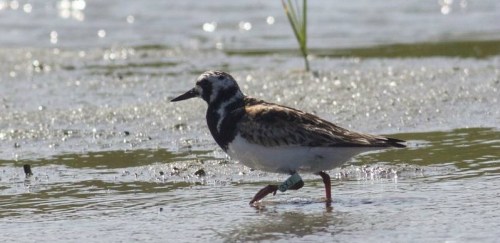
I was out on Cape Cod this September, where one of the many joys is watching sea birds running along the shores, pecking their beaks in the sand, or soaring above the surf at sun rise or sun set, when I first read a report in a magazine called Science about the significant crash in bird populations across North America over the past 50 or so years.
According to the study cited in the magazine, a continued loss of natural habitat, including woodlands, wetlands, and natural pastures to urban sprawl and agriculture has played no small part in the disappearance of an estimated three billion wild birds.
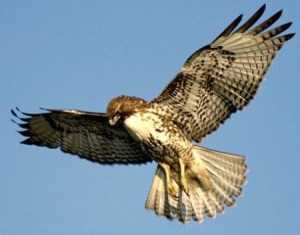
Red-tail hawk in flight over Niagara Escarpment. File photo courtesy of Niagara Peninsula Conservation Authority
Now, in a new report that the United States chapter of the Audubon Society highlights in material it circulated to the media this October 10th, the cumulative impacts of a rapidly changing climate could result in th loss of two thirds of the birds that are left on this continent in the decades to come.
Through the 1980s and 90s, while I was working as an environment reporter at a daily newspaper in Niagara, I covered more than my share of disturbing stories about toxic waste dumps and poisoned waters and lands, and the harm they did to peoples’ lives.
There were stories that made me feel hopeful too. And among them were stories about the work people from public agencies, from nature clubs, and some of them just caring freelancers, were doing to care for orphaned or injured owls, hawks and other birds, or to return populations of wild turkeys and bald eagles to this region after they had virtually gone extinct.
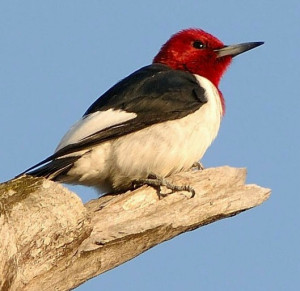
A Red-headed woodpecker, one of the many birds with a home in Waverly Woods in Fort Erie – another natural heritage area being targeted for urban development in this region. The gutting of these areas has got to stop! File photo courtesy of Marcie Jacklin and Community Voices of Fort Erie.
In my mind, I can still see their smiles and the look of pride on their faces as they talked to me about this good work and I can only imagine how some of them, no longer with us, would receive the news in the Science journal and this most recent Audubon Society report.
Can you imagine a world with significantly fewer birds or with more species of birds that have gone completely extinct.
We can’t let this happen and we have to do everything possible to stop it.
The Audubon Society news release below lists a number of things that we humans can do, including –
- “Advocate for natural solutions, from increasing wetlands along coasts and rivers that absorb soaking rains to protecting forests and grasslands that are homes to birds and serve as carbon storage banks, and putting native plants everywhere to help birds adapt to climate change.”
- “Ask elected leaders to be climate and conservation champions.”
In our region of Niagara, those steps must include urging our political leaders at the municipal, provincial and federal level to immediately cancel any development plans on the books for rich woodland, wetland and grassland areas like Thundering Waters Forest in Niagara Falls and Waverly Woods in Fort Eire.
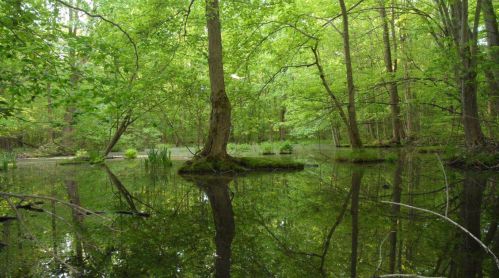
A look at wetlands inside Thundering Waters Forest in Niagara Falls, Ontario – a sprawling green area now a target for urban sprawl. This piece of Niagara’s natural heritage hosts numerous birds and other wildlife species and it is time to tell our politicians to say “no” to the development plans now for ecosystems like this or face the consequences on voting day.
We can no longer afford to continue paving over what we have left in Niagara of significant ecosystems like this, and there is no excuse for it when there are plenty of other places in the region where building would not have as significant an impact on wildlife.
And if our elected leaders refuse to protect these places – if they fail to be the “climate and conservation champions” this world now so desperately needs – there are elections, starting with this October 21st’s federal election – that we should use to vote in candidates who will and vote out those who won’t.
I am going to keep repeating this right up to October 21st, stay engaged in this election, find candidates that convince you that they care about environmental protection and will make addressing the climate emergency we are now facing a number one priority, and vote as if your future and the future of this planet are at stake, because they are!
Now here is the news release from the U.S-based National Audubon Society –
Survival By Degrees – 389 Bird Species on the Brink
NEW YORK – This October 10th, 2019, the National Audubon Society announced a groundbreaking climate report, Survival by Degrees: 389 Bird Species on the Brink.
“Two-thirds of America’s birds are threatened with extinction from climate change, but keeping global temperatures down will help up to 76 percent of them. There’s hope in this report, but first, it’ll break your heart if you care about birds and what they tell us about the ecosystems we share with them. It’s a bird emergency,” said David Yarnold, , CEO and president of Audubon.
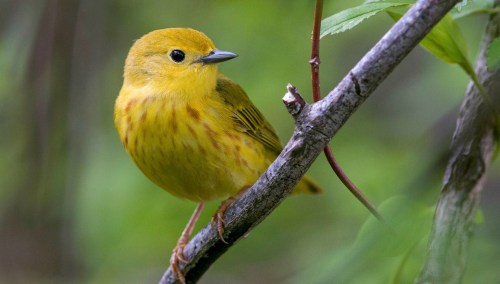
Yellow Warbler_National Audubon photo-Brian-Collier
“A lot of people paid attention to last month’s report that North America has lost nearly a third of its birds. This new data pivots forward and imagines an even more frightening future,” Yarnold said. “And, you can use a first-of-its kind web tool to find threatened birds in your zip code, as well as a list of things everyone can do.”
Audubon scientists studied 604 North American bird species using 140 million bird records, including observational data from bird lovers and field biologists across the country.
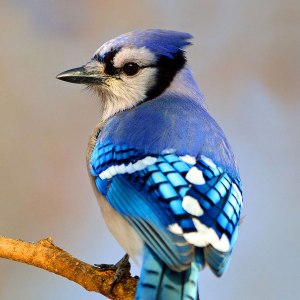
A Blue Jay. Audubon photo by Brian Kushner
Audubon’s zip code-based tool, the Birds and Climate Visualizer, helps users understand the impacts to birds where they live, making climate change even more local, immediate and, for tens of millions of bird fans, deeply personal.
“Birds are important indicator species, because if an ecosystem is broken for birds, it is or soon will be for people too,” said Brooke Bateman, Ph.D., the senior climate scientist for the National Audubon Society. “When I was a child, my grandmother introduced me to the Common Loons that lived on the lake at my grandparent’s home in northern Wisconsin. Those loons are what drive my work today and I can’t imagine them leaving the U.S. entirely in summer but that’s what we’re facing if trends continue.”
Dr. Bateman and her team also studied climate-related impacts on birds across the lower 48 states, including sea level rise, Great Lakes level changes, urbanization, cropland expansion, drought, extreme spring heat, fire weather and heavy rain.
“We already know what we need to do to reduce global warming, and we already have a lot of the tools we need to take those steps. Now, what we need are more people committed to making sure those solutions are put into practice,” said Renee Stone, vice president of climate for the National Audubon Society. “Our elected officials at every level of government must hear from their constituents that this is a priority. Audubon is committed to protecting the places birds need now and in the future and taking action to address the root causes of climate change.”
Audubon has outlined five key steps:
- Reduce your use of energy at home and ask your elected officials to support energy-saving policies that reduce the overall demand for electricity and that save consumers money.
- Ask your elected officials to expand consumer-driven clean energy development that grows jobs in your community – like solar or wind power.
- Reduce the amount of carbon pollution released into the atmosphere. In order to drive down carbon emissions, we will need innovative economy-wide solutions that address every sector of the economy – like a fee on carbon. Another option is to address carbon emissions one sector at a time like setting a clean energy standard for electricity generation.
- Advocate for natural solutions, from increasing wetlands along coasts and rivers that absorb soaking rains to protecting forests and grasslands that are homes to birds and serve as carbon storage banks, and putting native plants everywhere to help birds adapt to climate change.
- Ask elected leaders to be climate and conservation champions.
Enter your zip code into Audubon’s Birds and Climate Visualizer to see how climate change will impact your birds, your community, and the ways you can help.
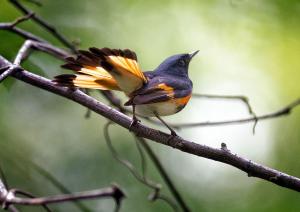
Baltimore Oriole. Audubon photo by Tom Warren
Audubon’s report is based on the 2014 Intergovernmental Panel on Climate Change (IPCC) report models for 1.5, 2.0 and 3.0 degrees C of global warming. At the highest warming scenario of 3.0 C, 305 bird species face three or more climate-related impacts.
Last month, Science published a study by a joint team of conservation biologists describing a grim picture: a steady decline of nearly three billion North American birds since 1970, primarily as a result of human activities. Climate change will further exacerbate the challenges birds are already facing from human activity.
In 2014, Audubon published its first Birds and Climate Change Report. The study showed that more than half of the bird species in North America could lose at least half of their current ranges by 2080 due to rising temperatures. Audubon’s new findings reflect an expanded and more precise data set, and indicate the dire situation for birds and the places they need will continue.
The full report, visuals and assets are available in the Media Kit.
###
About Audubon
The National Audubon Society protects birds and the places they need, today and tomorrow. Audubon works throughout the Americas using science, advocacy, education, and on-the-ground conservation. State programs, nature centers, chapters, and partners give Audubon an unparalleled wingspan that reaches millions of people each year to inform, inspire, and unite diverse communities in conservation action. A nonprofit conservation organization since 1905, Audubon believes in a world in which people and wildlife thrive. Learn more at www.audubon.org and on Facebook, Twitter and Instagram @audubonsociety.
For more on the new Audubon Society report, click on – https://www.audubon.org/climate/survivalbydegrees .
For more on the Science journal report, click on – https://www.3billionbirds.org/ .
To Niagara At Large readers – You may note that the Audubon Society report allows our American neighbours to punch in their Zip Code to find out more about the impacts on birds in their region. I do not see a function for Canadians to punch in a Postal Code. If anyone out there finds such a function, please email a link to it to drapers@vaxxine.com or share it in the comment space below, so that we can share it here.
NIAGARA AT LARGE encourages you to join the conversation by sharing your views on this post in the space following the Bernie Sanders quote below.
A reminder that we only post comments by individuals who also share their first and last names.
For more news and commentary from Niagara At Large – an independent, alternative voice for our greater bi-national Niagara region – become a regular visitor and subscriber to NAL at vihttp://www.niagaraatlarge.com .
